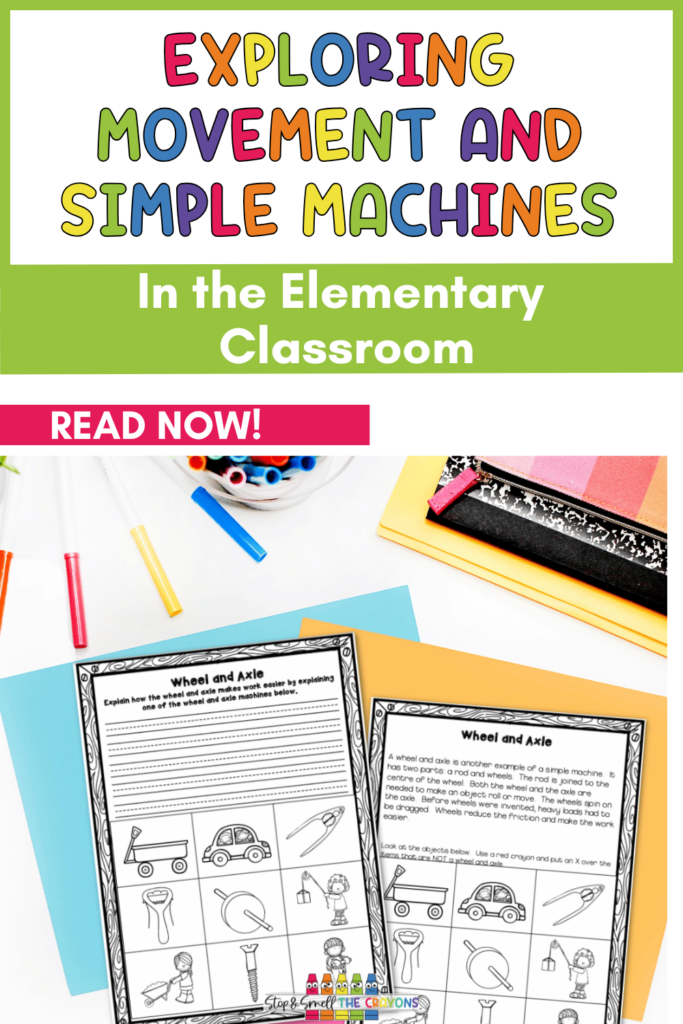Movement is all around us. It’s on the playground, in our homes, and even in the classroom. When I teach this unit on movement and simple machines, I love seeing how curious my students become as they start to notice how things work. They don’t just learn about the six types of simple machines. They get to experiment, build, observe, and play as they discover how movement and machines go hand in hand. This unit makes the science of everyday motion come alive with hands-on experiences that are easy to set up and meaningful for young learners. Today, we are exploring engaging activities that will help our students develop a deeper understanding of movement and simple machines, all while having a blast in the process!

Making Simple Machines Hands-On and Engaging

When I introduce simple machines to my students, I make it a priority to keep learning as hands-on as possible. I do this because these concepts might seem abstract at first. Once our students start building ramps or launching marshmallows with levers, everything clicks into place. They begin to understand how simple machines help us move objects with less effort. They start to recognize these machines all around them.
In this unit, I use everyday objects, like straws, rulers, boxes, and even marshmallows, to spark student curiosity. From exploring how a pulley lifts a load to experimenting with inclined planes and wheels, each activity gives my students a real-world connection that sticks. Plus, they love the chance to build, test, and try things out on their own or in small groups.
Simple Machines Unit Breakdown
It Starts with Movement

This unit dives into each of the six types of simple machines. It includes inclined plane, wedge, screw, lever, pulley, and wheel & axle. But. . . before we get to those, we start with the concept of movement. I begin with observation. As a class we go to various locations around the school (both indoors and outdoors) and just watch how things move. I encourage my students to watch for things like how the movement starts and stops, how long it continues, etc. Once we have done that, we head back to the classroom to discuss our observations. Through our discussion I weave in important vocabulary like pushing, pulling, sliding, rolling, and even bouncing. All of this talk about movement sets the stage for understanding how simple machines help make movement easier.
Once they’ve explored different kinds of movement, we move into discovering what a machine is and how simple machines help us every day. From scavenger hunts around the school to making pinwheels and catapults, every lesson builds on their growing understanding of how science and engineering connect to the world around them.
Simple Machines: Exploring Inclined Planes

I love to kick off our study of inclined planes with a challenge question. It would be something like this:
You are helping your uncle on his apple orchard. He has tasked you with moving an extra-large wagon filled with apples to the apple washing room. Then he points to the green building, the one that requires you to go up 6 stairs to reach the washing room platform. The platform is almost 4 feet off the ground. You grab the handle of the wagon and start pulling it toward the washing room. As you walk, you wonder how you are going to get the wagon all the way up there.
I give students a little time to think and work with a partner to come up with a plan. Then we discuss some of the plans students come up with. This challenge question really sets the stage for just how helpful inclined planes can be when doing heavy work.
Understanding Inclined Planes
I begin by explaining that an inclined plane is just a flat surface with one end raised or inclined. I love to get my students thinking and brainstorming about where they have seen inclined planes in the real world. From wheelchair ramps to slides on the playground, my students quickly recognize these in everyday life.
Throughout our unit on simple machines, I will repeatedly tell my students that simple machines help make work easier. We talk specifically about how ramps reduce the amount of force needed to move something. Then we head back to the apple orchard and talk about how a ramp could be helpful when it comes to moving a wagon filled with apples 4 feet in the air. It doesn’t take long for students to realize that creating a ramp is easier than pulling a wagon up 6 stairs, or unloading and reloading the wagon in order to lift it.
Next up, it is time for some hands-on exploration of inclined planes. One of our favorite activities is creating ramps using rulers and boxes. I have my students build their own inclined planes and test how different heights affect the movement of a toy car. They make predictions, test, and record what happens. It turns into a mini science experiment right at their desks! We also sketch real-life examples like moving truck ramps, boat launches, and even steep roads. By the end of this lesson, your students will truly understand how this simple machine helps us move things with less effort.
Discovering Wedges as Simple Machines

Wedges are one of those simple machines that our students don’t realize they see everywhere. I explain that a wedge is an inclined plane that moves and is often used to cut or split something apart. Once they know that, they start spotting wedges all over the place, from scissors and can openers to cheese graters and an ax, wedges are everywhere!
To dig deeper, we do a sorting activity where they identify which objects are wedges and which are not. They color-code or cross out images and discuss their choices with a partner. Then we choose a few common wedges and talk about how they reduce effort and help us complete everyday tasks. Some of my students love sharing how they’ve seen their parents using wedges in the kitchen or garage. It’s amazing how quickly they start noticing these machines in their world!
Through our exploration of wedges, students learn that wedges are used to split things, hold things, or tighten things. Students are usually quick to identify an ax as a wedge that splits things. But the other two are less obvious to them. We talk about how nails and tacks are wedges that hold things in place, and how a door stop is a wedge that tightens.
To help students understand the power of a wedge, I like to show this Curious Crew video by PBS Kids. It really pulls everything together and helps students see just what a great simple machine this is.
Making Connections With Wheels and Axles
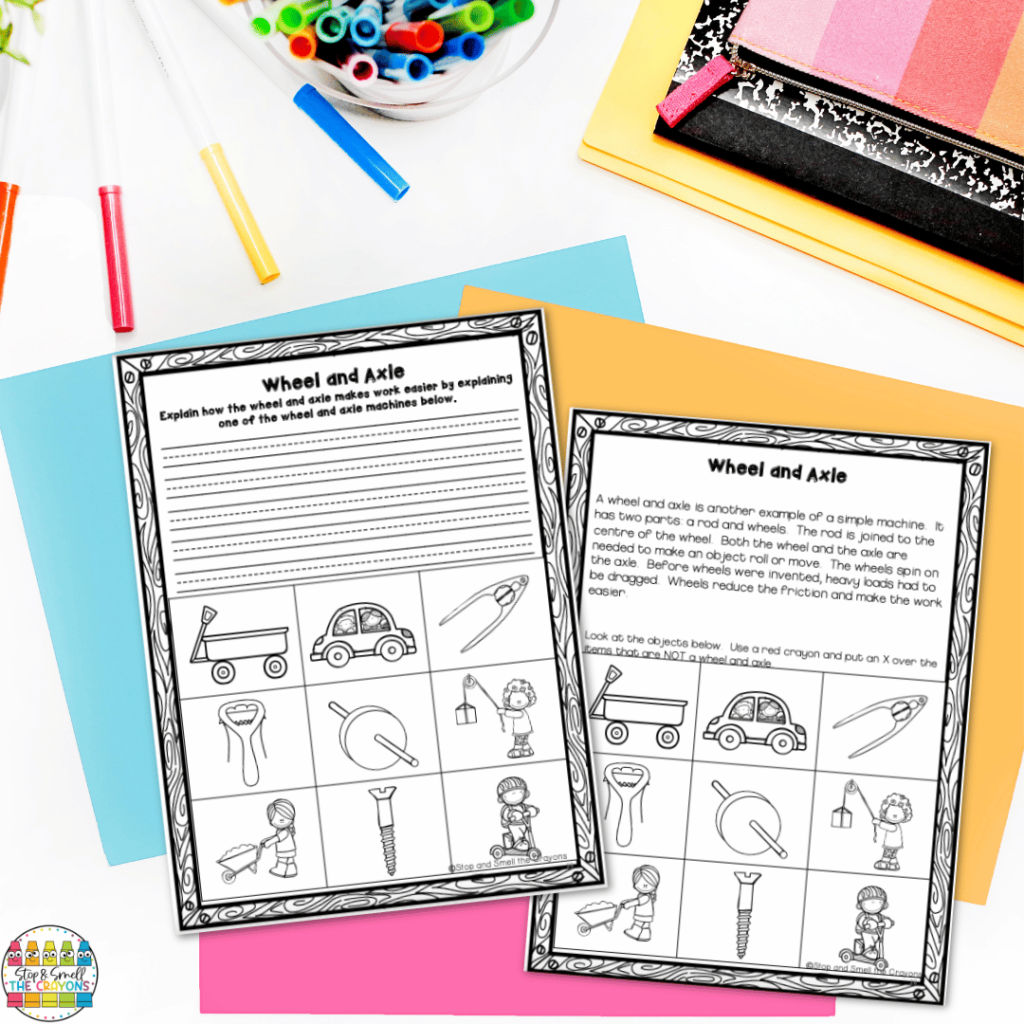
When we dive into wheel and axle simple machines, I like to start by asking my students to name anything with wheels. Bicycles, toy cars, scooters…and more. We quickly discover that this list grows fast! We talk about how the wheel and axle work together to make movement easier, especially when moving heavy objects across the floor or ground.
There’s no better way to understand how a wheel and axle work together than by building one. My students always love the hands-on project of building their own mini car. We use empty milk cartons from the cafeteria for the body of the car. Then we add straws for axles, and attach plastic lids or jar tops for wheels. I like giving students access to a variety of commonly found items so they can explore this simple machine.
Once the building is done, they test them out by racing them across the room or down an inclined plane. Some of the kiddos redesign their mini cars as they go for better movement, learning through trial and error. This project reinforces the concept of the wheel and axle but it also ties in problem-solving and collaboration.
Levers in Action
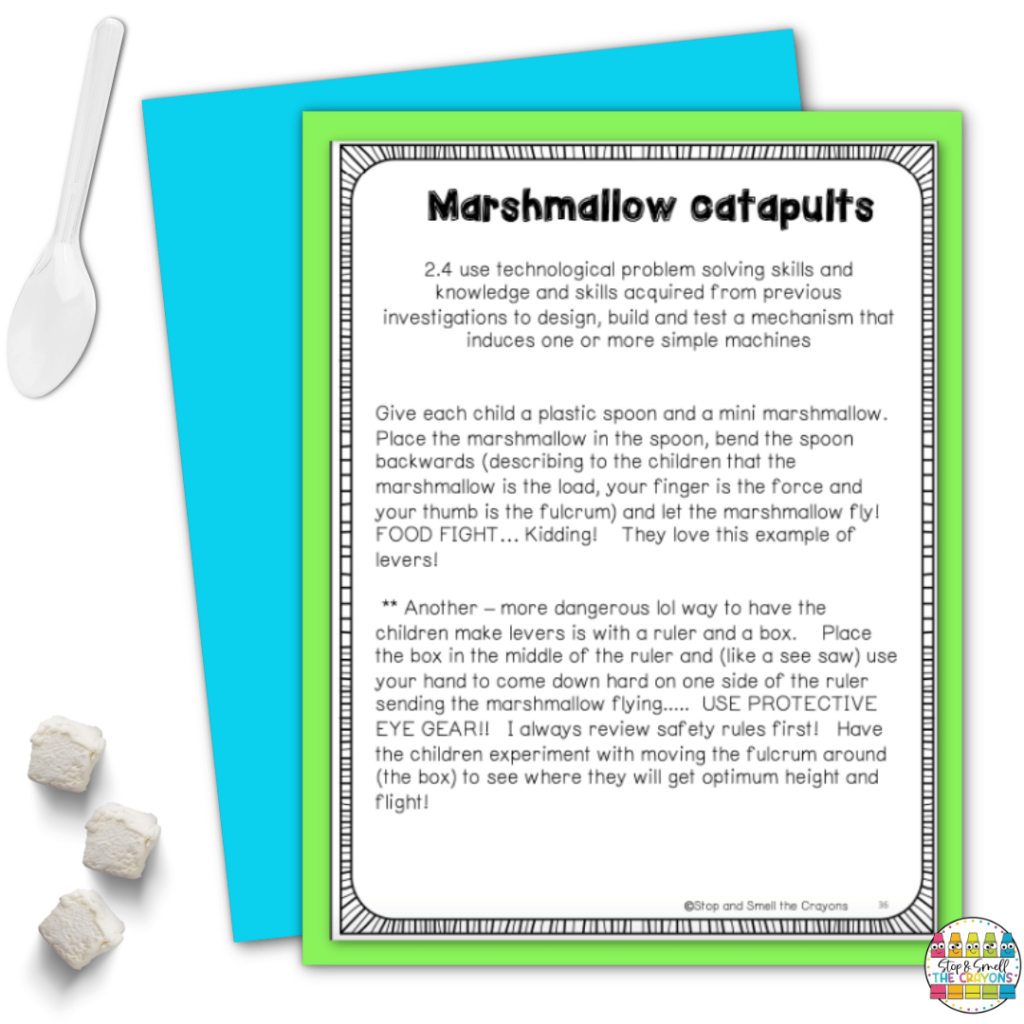
Levers are such an exciting part of our simple machines unit because they can be turned into games and experiments. I introduce levers by talking about seesaws, bottle openers, and even staplers. Then, we explore how a lever uses a bar and a pivot point (fulcrum) to help lift or move a load. I show them that with the right setup, they can lift something heavier than they expect and with very little effort.
One of our favorite lever activities is building marshmallow catapults. I have my students use a plastic spoon, their fingers, and mini marshmallows to create a working lever system. We name each part: load, fulcrum, and force. Then, we talk about how adjusting the fulcrum changes the distance the marshmallow can travel.
Another great activity is balancing different items on a ruler placed over a box. My kiddos experiment with moving the fulcrum to find the best balance. It’s all about exploring and observing how levers give us an advantage when doing work!
One of my favorite ways to illustrate levers in action is with the Looney Tunes Wile Coyote and Roadrunner. This video montage features multiple uses of a lever as the coyote tries to catch the roadrunner. It’s a great way to engage students in learning about the value of levers and simple machines.
The Power of the Pulley
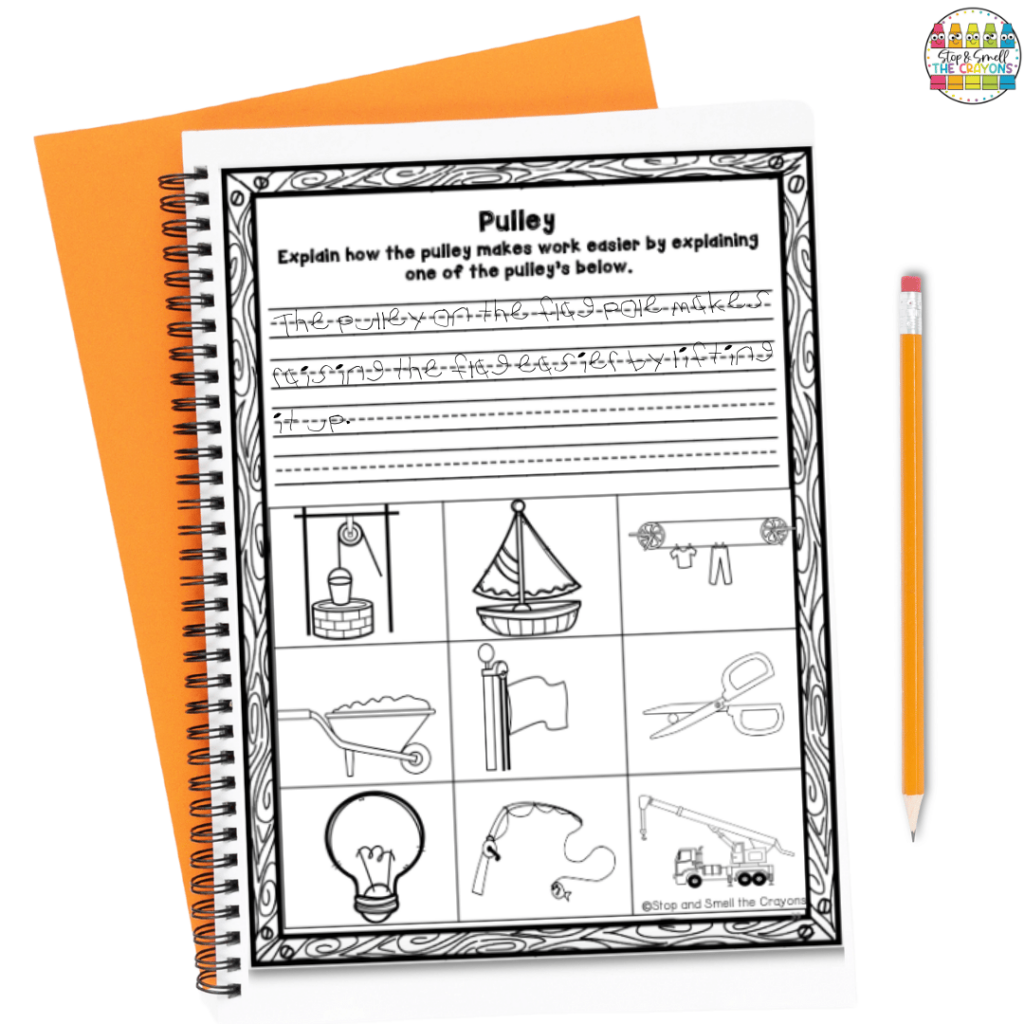
Exploring pulleys brings the “wow” factor to our simple machines unit! I explain that a pulley uses a wheel and rope to move an object and that it changes the direction of the force. When we pull down on one end, the load goes up on the other. If we pull right, the load moves left. This never fails to amaze my students!
We then do a class brainstorm of pulley examples they’ve seen, such as flagpoles, blinds, fishing rods, and cranes. We wrap up this part of the unit with a picture sort and writing activity that challenges them to explain how pulleys help reduce effort. It’s a great way to reinforce both science content and language skills.
It’s always fun to explore how pulleys help us with some hands-on activities. I like to use a few basic materials to model pulleys, such as string, spools, or rolling pins. Then, we try lifting light classroom objects like pencil boxes or clipboards. To help students see and feel the difference, we put in place a “rule” like you can only use two fingers or we limit the range of motion to the wrist instead of the arm. This helps simulate heavy work so that students can experience the benefits of pulleys.
Twisting Into Screws
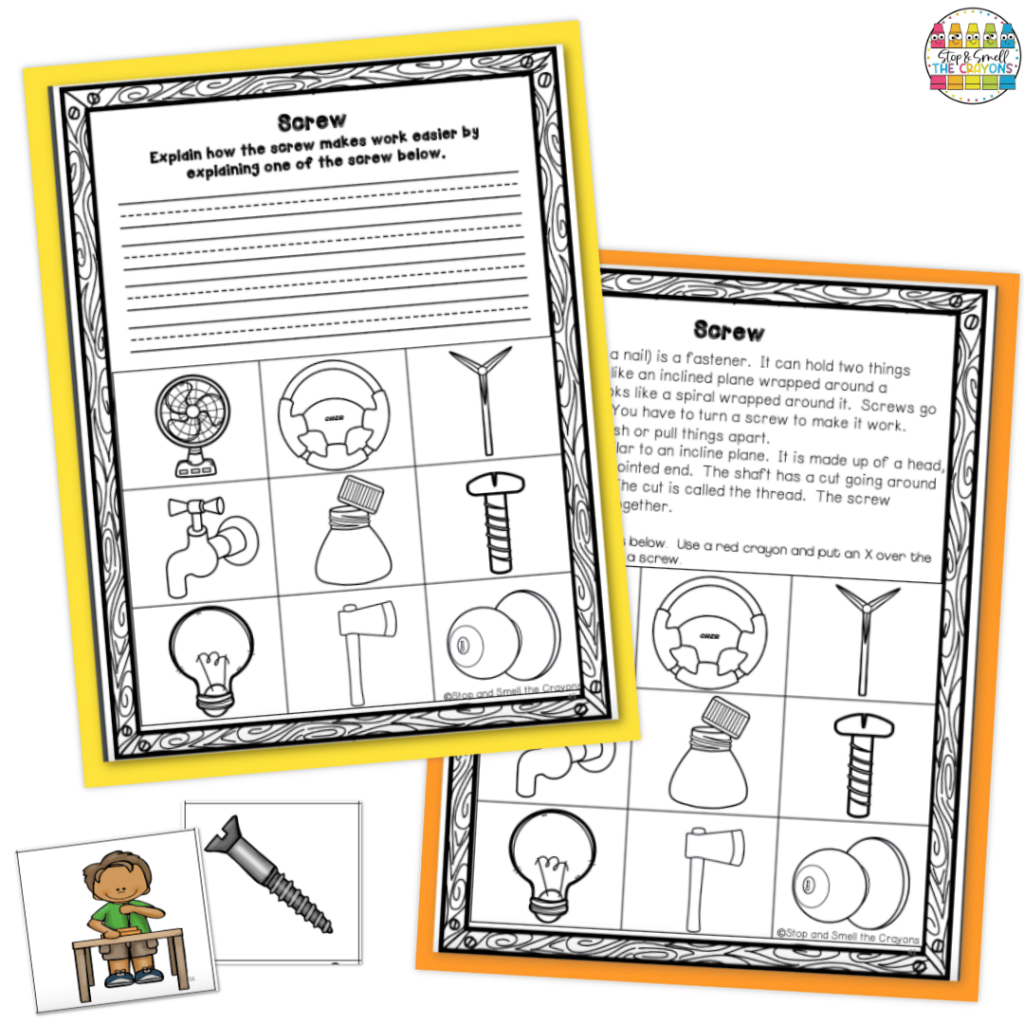
To finish up the six simple machines, we explore screws. I explain that a screw is just an inclined plane wrapped around a cylinder. It fastens objects together and helps us apply force gradually. Screws are everywhere! My students are always surprised to realize that they’ve been using them without knowing it when it comes to pencil sharpeners, jar lids, and even light bulbs.
We do a sorting activity where they need to identify different objects that use screws and write about how they help. Then, we compare screws to nails to see how the thread gives a screw more holding power. This leads to great discussions about when to use one over the other. I also love having my students explain a screw’s purpose in something they’ve used recently, like a twist-top water bottle or a hand-held pencil sharpener. These connections help them see the science in their everyday routines.
A Real World Example
To finish up screws, I like to jump back to our inclined place activity. Students had the chance to explore how different lengths and angles of inclined planes affected the car. After getting them to recall what they learned, I pose them with a real-life challenge:
You are an architect designing a new shopping mall. The mall must have a place for customers to park, so you decide to build a 10-story parking garage. You must include a way for cars to move up and down the parking garage safely and quickly. And. . . everything must fit in the space you have allocated for the parking garage.
This challenge question is the perfect way for students to see how a screw is beneficial. The students are usually quick to identify that a tall, steep ramp isn’t going to work. Through our discussion of possible ideas, it doesn’t take long to get to the screw. Students see how they can make an inclined plane a safe driving ramp just by winding it around.
Bringing Simple Machines To Life in the Classroom
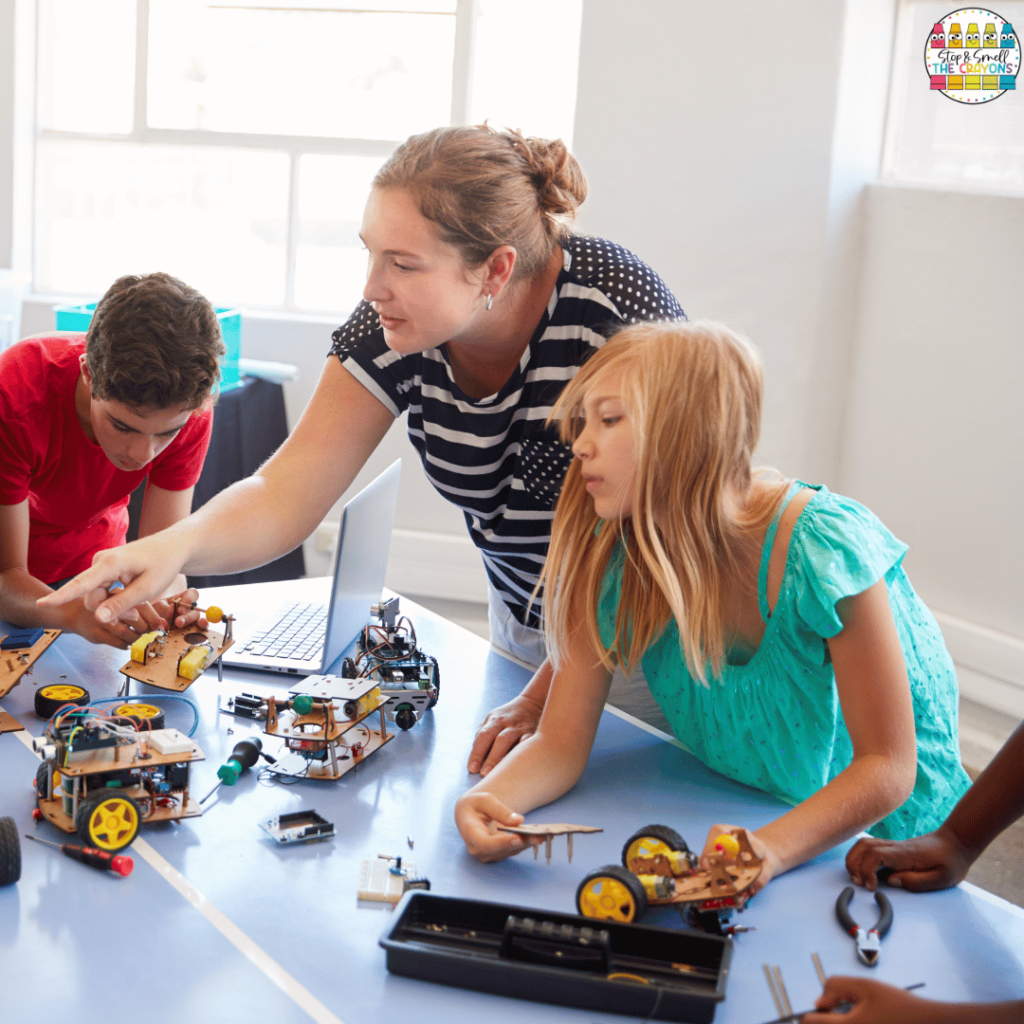
After we have spent a little time learning about each of the simple machines, we wrap it up with some activities that pull all the simple machines together. Students love learning about compound or complex machines and how they are just multiple simple machines put together.
Teaching simple machines through hands-on, real-world activities transforms science into something our students can see, touch, and understand. Whether they’re building ramps, creating marshmallow catapults, or designing their own pulley systems, they’re actively learning how these machines help us move and work with less effort. Each activity in this unit encourages curiosity, critical thinking, and problem-solving, all while making learning fun.
What I love most is watching my students begin to spot simple machines in their daily lives. They notice the wheels on their toy trucks, the screws in their pencil sharpeners, and the levers on the playground. These moments of discovery show me that these lessons really stick. With each new concept, they’re developing a better understanding of how science shapes the world around them.
A Year of Science Made Simple and Fun
If you’re looking to build on this excitement all year long, be sure to check out Second Grade Science: A Year of Exploration. This year-long curriculum includes a full set of hands-on units that cover key science topics in a way that’s approachable and engaging for your young learners. From investigating simple machines to exploring air, water, animals, and matter, every unit is packed with lessons that make science meaningful.

My simple machines unit is just one part of this larger curriculum. It fits right in with the overall theme, which is helping our students explore, question, and connect with the world around them. Whether you’re just starting your science block or looking for a new way to refresh your lessons, this curriculum gives you everything you need to keep learning fun, active, and full of discovery. Want to learn about my other science units? Check out these blog posts:
- Exciting Hands-on Activities for Teaching Air and Water in the Environment
- Engaging Activities for Teaching Properties of Liquids and Solids
- The Fascinating World of Materials, Objects, and Everyday Structures
- Fun Ways to Teach Needs and Characteristics of Living Things
Save for Later
Remember to save this post to your favorite Science Pinterest board for quick access to this Simple Machines unit!
